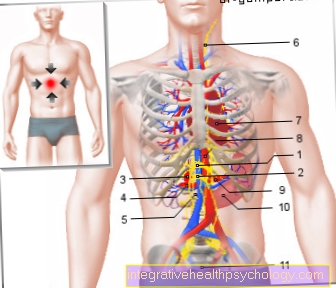solar plexus
introduction
The solar plexus (Solar plexus, Latin "solar plexus") is an autonomous nerve plexus of sympathetic and parasympathetic nerve fibers, as well as the union of three large ganglia. It is located in the abdomen at the level of the 1st lumbar vertebra and is used to connect and transmit important information. This allows him to control the peristalsis of the intestine, for example.

Position of the solar plexus
The solar plexus is approximately at the level of the 12th thoracic vertebra or 1st lumbar vertebra. Topographically, it can be found behind the stomach and the omental bursa and directly in front of the two legs (crura) of the diaphragm. It is grouped around the celiac trunk, the superior mesenteric artery and the branch off of the renal artery.
The solar plexus is made up of two nerve plexuses, the celiac plexus and the superior mesenteric plexus (plexus = nerve plexus). Most of the nerves come from the abdominal organs and run up through the chest cavity to the brain and vice versa. In order to be able to do this as protected as possible, they accompany the larger blood vessels. The largest blood vessel in the chest and abdomen is the so-called aorta, the main artery. This runs along the back wall of the abdominal cavity, where it passes through a gap in the diaphragm into the chest cavity. The nerves follow the aorta and form the solar plexus at the level between the twelfth thoracic vertebra and the first lumbar vertebra. If you project this forward onto the skin of the abdomen, you will find the solar plexus about a hand's breadth below the breastbone.
function
The nerve plexus is used to interconnect and transmit important information. This allows the nervous system to regulate functions of internal organs, for example the tension and relaxation of the intestinal muscles (intestinal peristalsis) or the secretion of the glands.
You might also be interested in this topic: The autonomic nervous system - mechanisms of action and function
Sensation of pressure and pain in the solar plexus
Feelings of pressure and Pain in the area of the solar plexus are more likely to affect the surrounding organs and structures. It refers to stomach, Colon, pancreas and the superficial abdominal and deep back muscles. In the most harmless case, a feeling of pressure can be confused by one digestion with a lot of air in the colon or in the sense of a Bloating from the stomach. If the area over the solar plexus is tender on pressure, there may be one Inflammation of the stomach lining in front.
Accompanying one would nausea and if necessary Vomit expect. The stomach feels tender and strange firm and elastic at can it be a inflammation the pancreas (Pancreatitis) act. Here one would expect the pain belt-shaped radiate into the back. Also Tension in the back can possibly irritate the core of the body, e.g. sitting for long periods of time or crooked posture or unfamiliar surfaces when sleeping. Some recommend themselves here short stretching and yoga exercises after getting up, e.g. the Sun salutation.
Illustration of the solar plexus

Solar plexus - Solar plexus
(Nerve fiber plexus 1. + 2.))
- Nerve plexus around the liver,
Splenic and gastric arteries -
Celiac plexus - Upper mesenteric nerve plexus -
Superior mesenteric plexus - Trunk of the liver, spleen,
and gastric arteries -
Celiac trunk - Renal artery - Renal artery
- First lumbar vertebra -
Vertebra lumbalis I - Vagus (10th cranial nerve) -
Vagus nerve (X) - Pericardium -
Pericardium - Abdominal aorta (descending aorta) -
Abdominal aorta - Upper mesenteric artery -
Superior mesenteric artery - Stomach body -
Corpus gastricum - Lumbar cruciate ligament kink -
Promontory
You can find an overview of all Dr-Gumpert images at: medical illustrations
What happens if I hit the solar plexus?
The solar plexus contains fibers of the so-called autonomic nervous system (autonomous = independent). The autonomic nervous system is responsible for the regulation and control of the organswhich cannot be influenced at will. Two opponents are responsible for this: one puts the body in Alert and get it ready to go (Sympathetic), the other is more for Relaxation responsible and reports to the brain how the organs are doing (Parasympathetic nervous system). About a complex cycle of control and countermeasures are, for example, the Heartbeat, Lung function, the activity of entire gastrointestinal tract and the Blood flow to the organs influenced.
Arrives powerful blow this nerve plexus then becomes this through it improperly stimulated and reacts to this stimulus with a excessive reaction. There is the command to Dilatation of all blood vessels in the abdomen, briefly "sinks“The blood there and there is too little flowing back to the heart. In addition, the heart receives the command beat slower. The combination of these two responses to the beat accordingly leads to less blood being pumped on from the heart, the Inflow to the brain is briefly reduced and this can be done in dizziness result up to unconsciousness.
In a healthy body, this mismatch is within a few seconds recognized and counteracted by the active part of the autonomic nervous system. The state will balanced and blood flow returns to normal. However, this process sets the sufferer temporarily incapacitated until there is enough blood in the brain arrives. The Pain hold something else longer because of the sudden Bruising of the abdominal organs the blow ignites a whole firework of pain, so to speak.
How can you relax the solar plexus?
Since the solar plexus is not a muscle, it cannot be relaxed in that sense. However, it consists largely of autonomic nerve fibers that are responsible for relaxing the abdominal cavity and promoting digestive activity. Relaxing the solar plexus means stimulating the part of the nervous system that causes relaxation.This is achieved, for example, through targeted breathing exercises, which have a calming effect.
Inhaling and exhaling slowly, with an exhale twice as long as the inhale, can help calm the mind and body and slow the heartbeat. Sitting upright has a supportive effect and takes pressure off the solar plexus. Yoga is also ideal for opening the chest and stomach, strengthening and relaxing the muscles.
QiGong and other Far Eastern relaxation and meditation techniques are also often designed to relax and strengthen the core of the body and thus to bring about a free solar plexus in everyday life.
Please also read our topic on this Relaxation techniques.
Tattoo on the solar plexus
The skin over the region of the solar plexus is not so much supplied by the nerves of the solar plexus, but mainly by the sensitive ones Cutaneous nerves of the spinal cord. At the level of each vertebral or spinal cord segment, nerves emerge that give rise to a specific one care for the belt-shaped area of the skin, a so-called Dermatome. The area above the solar plexus is supplied by the nerves Th8-9 (“Th” for thorax = chest). A tattoo on the solar plexus is just as painful as anywhere else on the abdomen, as the different dermatomes don't care much in terms of pain sensitivity.
In fact, since the area is not on the ribs, it may be less painful than directly on the ribs, where the bone underneath offers little cushion. The slimmer you are and the less subcutaneous fatty tissue there is between the skin and the abdominal organs, the more likely it is that these will be irritated and nauseated when tattooing. A good indication of whether the area is sensitive to pain is the question of how well the part of the body is supplied with nerves.
In the feet and hands, for example, a lot of nerves converge because these parts of the body have to feel particularly well in order to function. When tattooing the abdomen, the sensitivity to pain may vary from person to person. The more ticklish and sensitive you are on your stomach, the higher the likelihood that a tattoo will be painful there.
Summary
The solar plexus is a network of nerve fibers made up of sympathetic and parasympathetic fibers and is located in the abdomen near the aorta. It is used to interconnect and forward important information and thus regulate intestinal peristalsis and glandular secretion in the abdomen. Strong irritation of the solar pelxus can trigger massive vasodilation via the vagus nerve and, as a result, reduced blood flow to the brain. Dizziness or loss of consciousness can result.





























